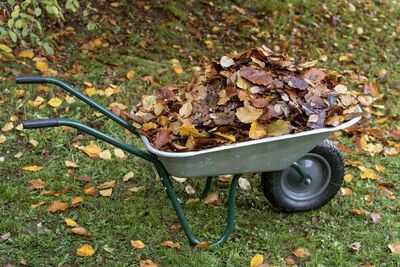Temperatures are starting to drop, which means winter is on the horizon - but that doesn't mean you can rest on your laurels. A gardening expert has shared how you can easily protect plants this month by collecting one garden scrap.
The TikTok creator, who goes by Ish, said that even though November is a cold month, it doesn't mean that there aren't a number of small jobs you can do to get your garden and plants ready for next spring. From planting spring bulbs to collecting fallen leaves, there are a number of gardening jobs you should do in the month of November. Here is how you can use fallen leaves to protect your plants.

Ish said: "This time of year, fallen leaves are plentiful, and you can use these in so many different ways. So don't throw them, keep them.
"You can use them; shred it up as a good mulch to protect your plants from frost. You can add them to your compost heap, help them break down into a nice compost.
"But you can also put them in a bag with holes in it and store it as a leaf mulch, too, which I like to add to the bottom of my borders in the spring. It will break down, providing all vital nutrients like nitrogen and potassium directly into your plants, and save you a lot of money on compost."
Mulch can help create a protective barrier for your plants when the frost sets in. This will keep the plants warm and also protect the roots from dying.
Fallen leaves can help protect the soil around where your plants are growing in the garden by helping to maintain soil health and stability, particularly through the colder winter months. The leaves can help regulate the temperature of the soil, insulating against the cold and retaining warmth as the weather changes.
Adding a layer of leaves can also provide insulation for the soil, preventing it from freezing deeply, which can damage a plant's roots. The protective layer can also help retain moisture, as the leaves will reduce the rate of evaporation.
Urban Gardeners also highlighted the significance of soil erosion during periods of extreme weather, such as strong winds and heavy rainfall, which can be expected in the autumn and winter months. It wrote: "The leaf coverage acts as a shield, absorbing the impact of raindrops and reducing the force of water flow over the soil surface. This prevents the dislodgment of soil particles and minimizes runoff, which can carry away the nutrient-rich topsoil.
"By slowing down water movement, the leaves allow more water to infiltrate the ground, enhancing soil moisture levels and reducing the risk of erosion."
Horticulture magazine recommends shredding the leaves with a mulching mower, shredder or leaf blower on the vacuum setting, especially if you're using generous amounts of mulch. However, if you're using a light coating of leaves, they won't need to be shredded.
The publication warned against using thick layers of leaves when trying to protect plants. It explained that too many leaves would do the "exact opposite" of its intended purpose.
Horticulture explained that a thick layer of leaves could lock in too much moisture, which could potentially damage any plants that are susceptible to rot and other fungal diseases. It also said: "Lastly, deep leaf cover can appeal to timid wildlife like mice and voles, because it allows them to tunnel; for this reason, pull leaves back from the base of shrubs and young trees that are prone to these critters' gnawing."
You may also like

Rs 1 crore every day! Hyderabad police chief tots up people's daily loss to cybercrimes

AAI and Uttarakhand govt sign MoU for Naini Saini airport, move to streamline operations

Sir David Beckham celebrates knighthood honour with star-studded pub party

Shafali Verma's Inspiring Journey to ICC Women's World Cup Glory

Uttarakhand Silver Jubilee: Saints and seers praise PM Modi's infrastructure thrust in Devbhoomi







